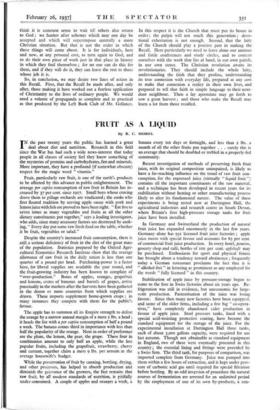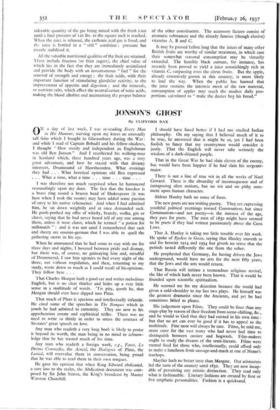FRUIT AS A LIQUID
By R. C. MOREL
IN the past twenty years the public has learned a great deal about diet and nutrition. Research in this field since the War has had such a wide news-interest that today People in all classes of society feel they know something of the mysteries of proteins and carbohydrates, fats and minerals. More important, they have a profound (if somewhat obscure) respect for the magic word " vitamin."
Fruit, particularly raw fruit, is one of the earth's products to be affected by this advance in public enlightenment. The average per capita consumption of raw fruit in Britain has in- creased by 37 per cent. since 1917. Small boys whose craving drove them to pillage orchards are vindicated; the cooks who first flouted tradition by serving apple sauce with pork and lenton juice with fish are proved to have been right. " Eat five to seven times as many vegetables and fruits as all the other dietary constituents put together," says a leading investigator, who adds, since many accessory factors are destroyed by cook- ing, " Every day put some raw fresh food on the table, whether it be fruit, vegetables or salad."
Despite the country's increased fruit consumption, there is still a serious deficiency of fruit in the diet of the great mass of the population. Statistics prepared by the Oxford Agri- cultural Economics Research Institute show that the average allowance of raw fruit in the daily ration is less than one quarter of a pound per head. Purchasing-power is a factor here, for liberal supplies are available the year round, and the fruit-growing indUstry has been known to complain of "over-production." Boxes of apples, oranges, grapefruit and lemons, crates of bananas and barrels of grapes, arrive punctually in the markets after the harvests have been gathered in the dozen or more countries from which supplies are drawn. These imports supplement home-grown crops ; in many instances they compete with them for the public's favour; - The apple has to summon all its Empire strength to defeat the orange by a narrow annual margin of a mere 2 lbs. a head ; it heads the list with a per capita consumption of half a pound a week. The banana comes third in importance with less than half the popularity of the orange. Next in order of preference are the plum, the lemon, the pear, the grape. These four in combination amount to only half an apple, while the less popular fruits, including the grapefruit, strawberry, cherry and currant, together claim a mere 9 lbs. per annum in the average housewife's budget.
. -While the preservation of fruit by canning, bottling, drying, and other processeS, his helped to abscirb production and truninish the grieVance of the growers., the fact remains that raw fruit, by all modern standards of nutrition, is pitifully under-consumed. A couple of apples and oranges a week, a banana every ten days or fortnight, and less than 2 lbs. a month of all the other fruits put together . . . surely this is an average that should be doubled or trebled in a properly-fed community.
Recent investigation of methods of preserving fresh fruit juice, with its original composition unimpaired, is likely to have a far-reaching influence on the trend of raw fruit con- sumption, for the expressed juice (virtually " liquid fruit ") contains all the important constituents of the raw material, and a technique has been developed in recent years for its stabilisation without heating or other manufacturing process likely to alter its fundamental nature. The value of these experiments is being tested now at Darlington Hall, the agricultural industries and research centre in South Devon, where Britain's first high-pressure storage tanks for fruit juice have been installed.
In Germany and Switzerland the production of natural fruit juice has expanded enormously in the last few years. Germany alone has 951 licensed fruit juice factories ; apple juice meets with special favour and accounts for 85 per cent. of commercial fruit juice production. In every hotel, pension, grocery shop and café, bottles of too per cent. apfelsaft may be purchased. Enthusiasm for sport and physical fitness has brought about a tendency toward abstinence ; frequently today a German restaurant proclaims the fact that it is " alkohol-frei " in lettering as prominent as any employed for the words " fully licensed " in this country.
Stabilisation of apple juice by pressure-storage began to come to the fore in Swiss factories about six years ago. Re- frigeration was still in evidence, but uneconomic for large- scale production. Pasteurisation of the juice was losing favour. Since then many new factories have been equipped, and some of the older firms, including a few big " co-opera- tives," have completely abandoned cider production in favour of apple juice. Steel pressure tanks, lined with a special acid-resisting protective coating, have become the standard equipment for the storage of the juice. For the experimental installation at Darlington Hall three tanks, each of about 5,000 gallons capacity, were required for use last autumn. Though not obtainable as standard equipment in England, two of these were eventually procured in this country; the essential lining and fittings were provided by a Swiss firm. The third tank, for purposes of comparison, was imported complete from Germany. Juice was pumped into them within a few hours of extraction, and is kept under pres- sure of carbonic acid gas until required for special filtration before bottling. By an odd inversion of procedure the natural courses -of fermentation are arrested for an unlimited period by the employment of one of its own by-products; a C011- siderable quantity of the gas being mixed with the fresh juice until a final pressure of 12o lbs. to the square inch is reached. When the juice is released, the carbonic acid gas is freed, and the juice is bottled in a " still " condition ; pressure has merely stabilised it.
All the valuable nutritional qualities of the fruit are retained. These include fructose (or fruit sugars), the chief value of which lies in the fact that they are immediately assimilated and provide the body with an instantaneous " fuel " for the renewal of strength and energy ; the fruit acids, with their important function of stimulating glandular activity, to the improvement of appetite and digestion ; and the minerals, or nutrient salts, which effect the neutralisation of toxic acids, making the blood alkaline and maintaining the proper balance of the other constituents. The accessory factors consist of aromatic substances and the already famous (though elusive) vitamins A, B and C.
It may be proved before long that the juices of many other British fruits are worthy of similar treatment, in which case their somewhat seasonal consumption may be virtually extended. The humble black currant, for instance, has recently been proved to yield a juice astonishingly rich in vitamin C, surpassing even the citrus fruits. But the apple, already extensively grown in this country, is more likely to lead the way. When the public has learned that the juice sustains the intrinsic merit of the raw material, consumption of apples may reach the modest daily pro- portions calculated to " make the doctor beg his bread."



















































 Previous page
Previous page